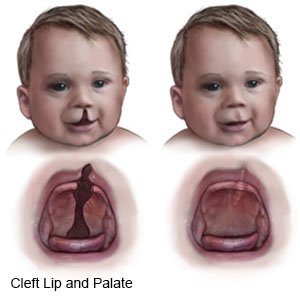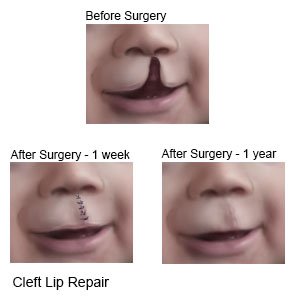Cleft Lip and Cleft Palate Repair
Medically reviewed by Drugs.com. Last updated on Aug 4, 2025.
What do I need to know about cleft lip or cleft palate repair?
Cleft lip and cleft palate repair is surgery to close the openings in your child's lip or mouth. Your child may have a cleft lip repair, a cleft palate repair, or both.
 |
 |
What can I do to help my child before surgery?
- Show your child the padded arm boards that will be used after surgery. Explain that they are to keep him or her from touching his or her mouth by accident. Put the padded arm boards on your child for a short time. This will help your child be less afraid if the boards are put on after surgery.
- Teach your child to drink from a cup, the side of a spoon, or a syringe. This may help prepare your child for new ways to drink after surgery.
- Practice cleaning your child's mouth. Sit your child up with his or her head forward. Gently spray water or salt water on the roof of your child's mouth with a spray bottle as directed. Let your child hold the spray bottle so he or she will not be afraid.
How do I prepare my child for surgery?
- Your child's healthcare provider will tell you how to prepare your child for surgery. The provider may tell you not to let your child have anything to eat or drink the night before surgery.
- Ask your child's healthcare provider before you give your child any medicine on the day of surgery. These medicines include insulin, antibiotics, over-the-counter medicines, vitamins, or prescription medicines.
- Your child may be given antibiotics to prevent an infection. Medicine may be given in your child's IV to help him or her feel relaxed or drowsy. Your child will also be given general anesthesia to keep him or her asleep during surgery. Tell the healthcare provider if your child has ever had an allergic reaction to antibiotics or anesthesia.
What will happen during surgery?
The surgeon will cut along each side of the cleft. Tissue from both sides of the cleft will be brought together to close the hole. The edges are sewn together with stitches. These will help the wound stay closed as the cleft heals. If your child's cleft involves his or her nose, the nostril may be reshaped at this time or in a later surgery.
What should I expect after surgery?
- Your child may have some pain or discomfort when he or she swallows. He or she may be given pain medicine.
- You will be shown how to clean the stitches. You will need to clean the stitches as directed when your child goes home from the hospital. Padded arm bands will be placed on your child. They keep your child from bending his or her elbows. This will prevent your child from touching the stitches. The arm bands will stay on for about 10 days after surgery.
- Your child will stay in the hospital overnight or until he or she can drink liquids again.
What are the risks of surgery?
Your child may bleed more than usual or get an infection after surgery. He or she may have trouble breathing or get blood clots. Your child can damage the incision by putting his or her hands or an object into his or her mouth. If your child's skin separates from the stitches, surgery may have to be done again. This may also cause more scarring. The most common problem with cleft lip repair is when the side of the repaired lip does not line up with the other side. The most common problem with cleft palate repair is poor healing. It is common for children with clefts to need repair surgery more than 1 time.
Care Agreement
You have the right to help plan your child's care. Learn about your child's health condition and how it may be treated. Discuss treatment options with your child's healthcare providers to decide what care you want for your child. The above information is an educational aid only. It is not intended as medical advice for individual conditions or treatments. Talk to your doctor, nurse or pharmacist before following any medical regimen to see if it is safe and effective for you.© Copyright Merative 2025 Information is for End User's use only and may not be sold, redistributed or otherwise used for commercial purposes.
Further information
Always consult your healthcare provider to ensure the information displayed on this page applies to your personal circumstances.
